There are many helpful videos on YouTube with great illustrations of Kaizen and continuous improvement mindsets and principles.
In this post, I'm going to share three videos:
- One about a small team's improvements
- One about Kaizen in a health system
- One about Kaizen at Toyota
Kaizen Upon Kaizen in a Team
In this video, Ashley explains how a Kaizen took a few iterations… people were building upon each other's Kaizens.
Sadly, the video is no longer available.
The starting point was this… a leaf that was starting to look bad, a leaf that was intended to show who was on garden duty.
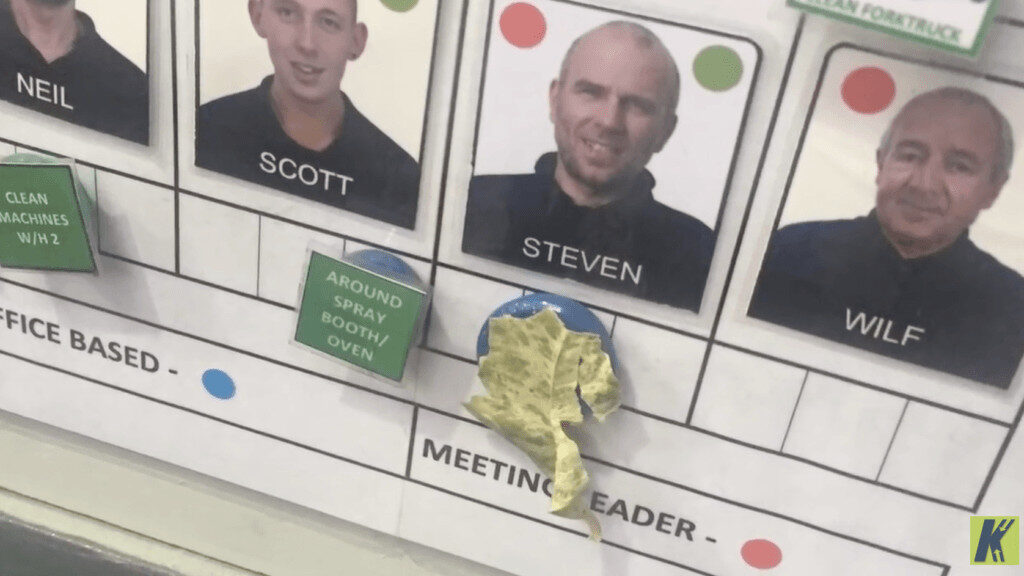
Ashley put up a fresh leaf…
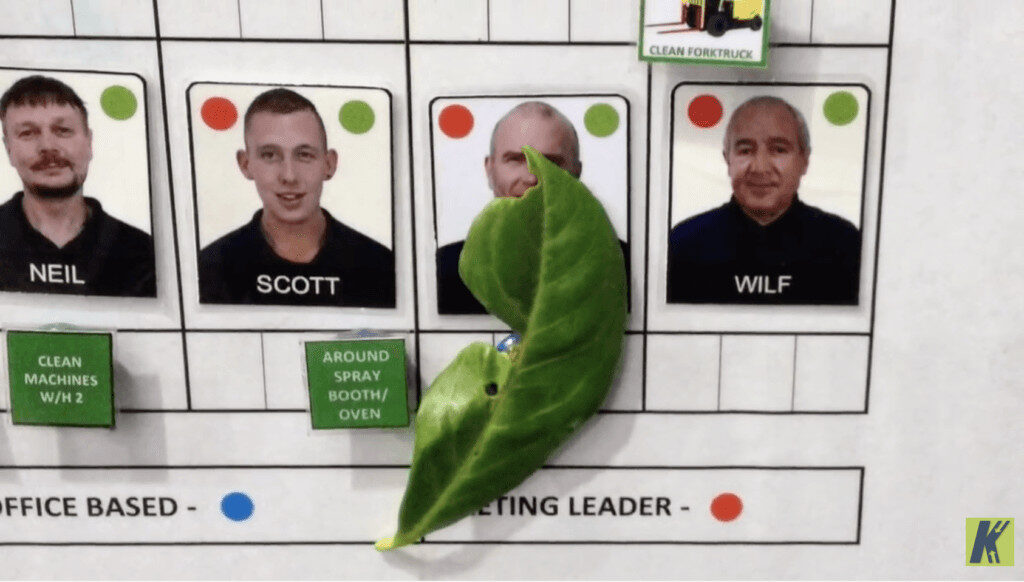
And a colleague put up what looks like a laminated card, as you see below:
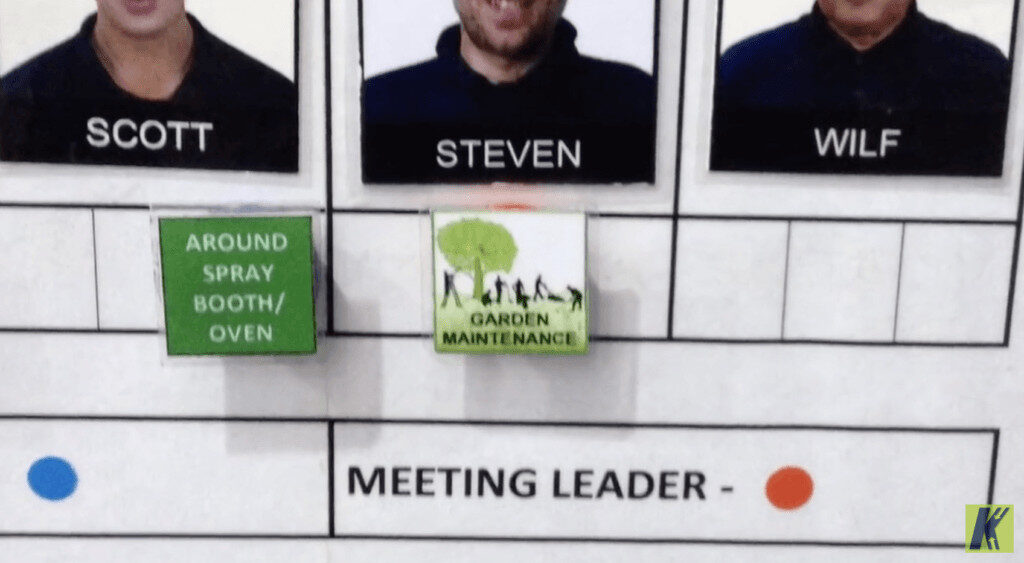
As Ashley said, in their team, people don't get bothered by somebody improving their improvement. That's the “true spirit of Kaizen,” as he puts it.
Two weeks ago, at Franciscan St. Francis Health, we heard many similar stories about what they call “Kaizen Upon Kaizen.”
We wrote about this in Healthcare Kaizen, and one such story is in Chapter 1 (which you can download here). Here's an excerpt:
Kaizen Upon Kaizen Upon Kaizen
Kaizens can be improved upon over time, like stair steps, with each improvement moving you closer to your work being flawless–the best it possibly could be. The following examples illustrate how staff-driven Kaizen can be iterative and cumulative over time.
In July of 2008, staff in the Franciscan NICU added Velcro® brand hook and loop fastener strips to tie back the privacy curtains when not in use, which prevented them from getting in the way of staff, while improving the aesthetics of the unit, as shown in Figure 1.7.
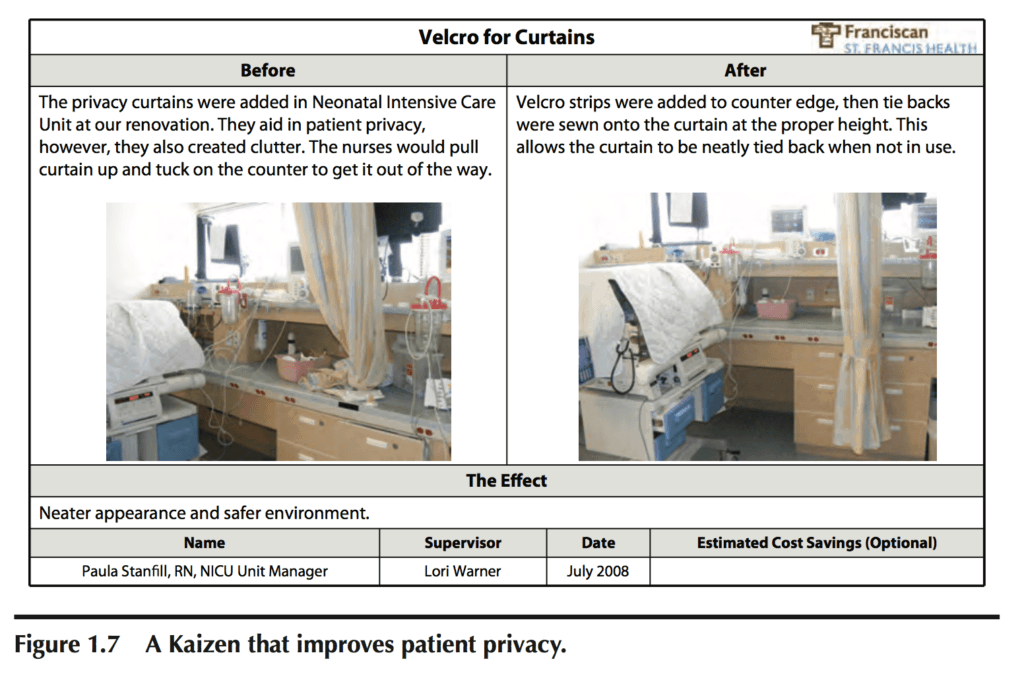
In June of 2009, they improved on the idea by adding signs to the curtains, as pictured in Figure 1.8.
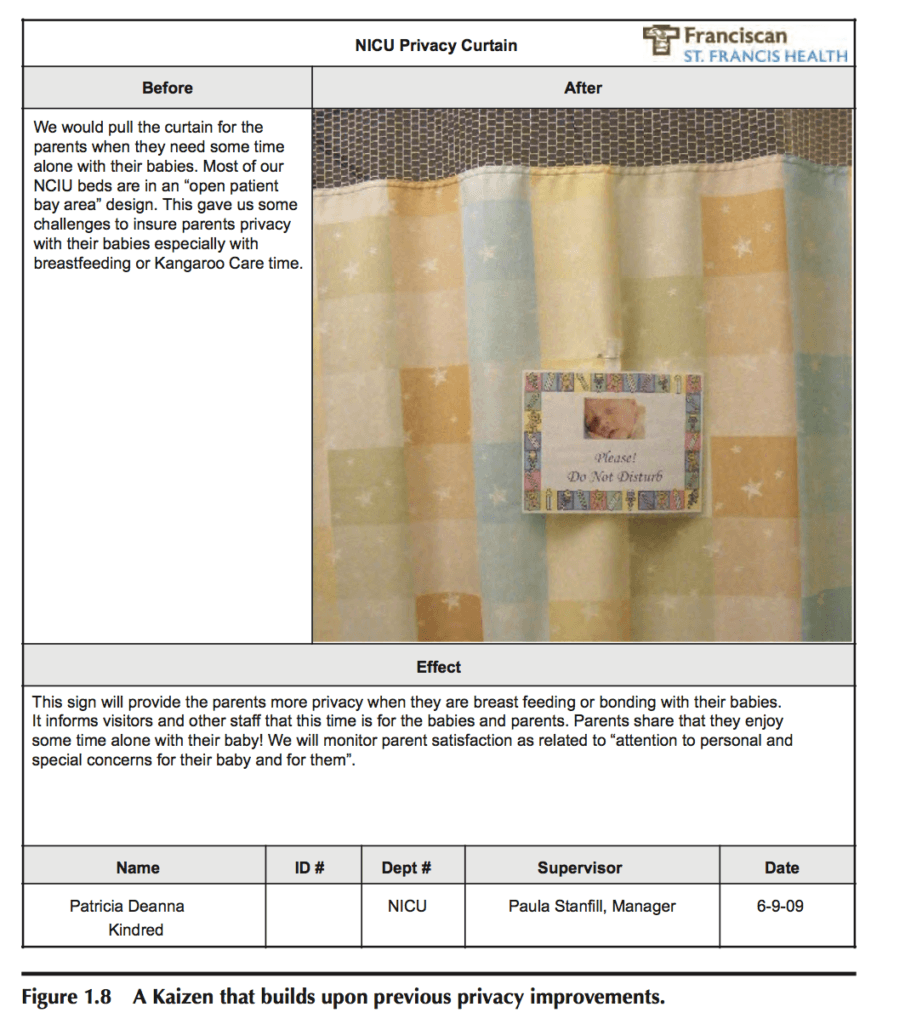
Then, in February of 2011, they added black clips to ensure the curtains did not have gaps that could reveal a mom breastfeeding her baby, a Kaizen that is documented in Figure 1.9. Over four years' time, the NICU staff members continuously made simple improvements to change their privacy curtains for the better. This series of Kaizens nicely demonstrates the compassionate concern the NICU nurses have for continually improving the care experience for both babies and parents.
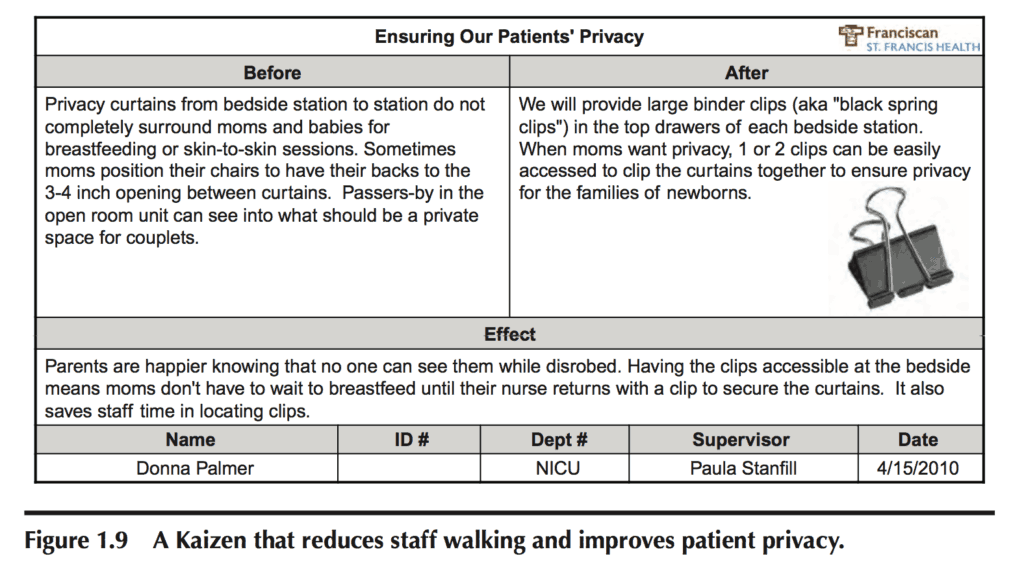
It would be counterproductive to look at the final improvement from 2011, and then ask, “Why didn't you come up with all of those improvements back in 2008?” Improvements often seem very obvious in hindsight, but the opportunities may be less obvious when mixed into the busyness of our daily work. All three of the above Kaizens should be celebrated in their own right. It goes to show when you embrace Kaizen, it can be very difficult to stop improving–at home or in the workplace. One small improvement begets others in a positive cycle.
What does your organization do to encourage “Kaizen Upon Kaizen Upon Kaizen?”
Kaizen in Healthcare
Staying on the theme of healthcare, here is a video that, while framed as being about architecture, actually illustrates MANY improvements that you could describe as Kaizen…
The Winneshiek Medical Center Rehab and Sports Medicine department refers to this as their “problem solving system,” which makes me think of last week's post and discussion about the words we use in Kaizen. I think there is agreement that we should use words that resonate with our people in our organization. But, I'd hope the broader Winneshiek Medical Center uses “problem solving system” as a consistent term across the whole organization (and they probably do).
Improvements and benefits on different levels include:
- Having the proper number of pillows in each room (so staff don't have to go searching for them and patients are more comfortable)
- They had struggled for a long time to fix a bad smell in a room, but with their problem solving process, they “had it fixed within a week” (it sounds like a more structured and scientific approach was helpful… not surprising)
- Less time fighting fires and more time working toward goals
- Colorful visual tags to help people see room status
- Their approach helps them work better across functions
- Better ways of notifying therapists about when their patients arrived
- A board to better track who was seeing each patient and if that had happened yet
- A home exercise packet with instructions for patients who had a total knee replacement
- Standardized work and scripting to talk with patients about billing concerns
- Starting a twice-a-week improvement huddle
I see a lot of smiles… joy and pride in improvement. That's always great to see! This screen capture shows the transition between two scenes… lots of smiles.
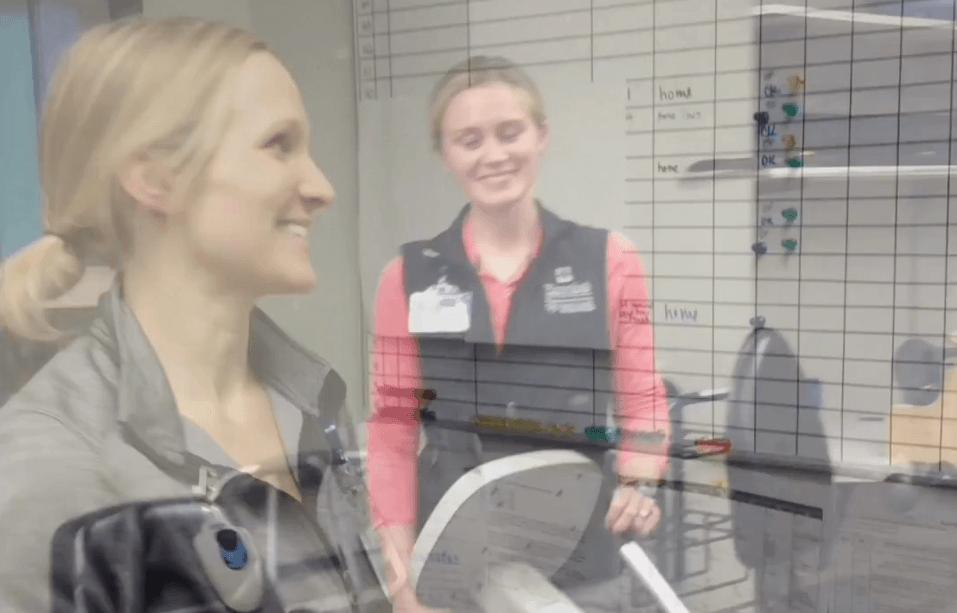
Staff are asked to describe their approach in one word and these are great answers:
- Teamwork
- Educational
- Communication
- Solving
- Cooperation
- More efficient
- FUN
- Effective
- Organization
- Streamline
- Improvement
- Collaboration
We ned more of this in healthcare!
Kaizen at Toyota
Yes, healthcare organizations don't build cars. But, Lean and Kaizen is not about building cars… it's about people. How we lead… how we improve. It's about how we engage everybody and their creativity.
Here's a clip from an organization that inspires many of us… Toyota. And this is a video from Derby, England, not Japan. Kaizen is pretty universal.
“Toyota are obsessed with their quest for continuous improvement.”
The host talks about Toyota working to make things “as efficient as possible,” but there's more to it than efficiency. SQDCM… Safety Quality Delivery Cost Morale.
As the host says:
“Kaizen is a team effort. Toyota encourages all of their employees to come up with two Kaizens every month.”
It's not just about setting a goal. Leaders need to work with people as coaches and facilitators to help make this happen. Leaders need to know when to help… and when to get out of the way.
The host says that everyone he meets has a Kaizen of their own. This was my experience in Japan, even with our Toyota tour guide:
As Masaaki Imai says, Kaizen is everybody, everywhere, every day.
Kaizen in San Antonio (TMMTX)
When I lived in San Antonio, there were a few times when I volunteered to go on the Toyota plant tour there with healthcare professionals and healthcare students. My role was to help translate what they saw into lessons for healthcare.
As I've blogged about, the visitor center features Kaizen a lot:
This video about the plant mentions Kaizen (this video is also no longer available).
And people hear about it during the tour.
During the Q&A session at the end of one tour, I remember a nurse asking the guide a question:
“You talked a lot about Kaizen, but people seemed busy building trucks… when is there time for Kaizen?”
The guide, who used to work in the paint shop said (I'm again paraphrasing):
“We look for time during the day. If the line goes down for some reason, we'll do Kaizen. If we can't find time, we'll talk to our team leader and they'll approve overtime to work on it.”
Jaws dropped amongst the healthcare people. Overtime??? But that's BAD! We've been told to cut overtime to cut costs!!! We're not allowed to have overtime.
Maybe it was the Group Leader who approved the overtime… but somebody would.
Choosing to pay for a bit of overtime is a good investment in the future of the plant in many ways:
- Developing the person who is doing Kaizen
- Improving safety, quality, productivity, cost, etc. is a good investment too
It's a CHOICE. Hospitals can make the choice to invest in people by paying for some overtime if they can't find time to do Kaizen during the day. But, if people are already working 12-hour shifts, they might be too exhausted to WANT more hours. Working 12-hour shifts can be bad for patient safety and quality, but that's a different discussion for a different day.
What do you think?
Please scroll down (or click) to post a comment. Connect with me on LinkedIn.
Let’s build a culture of continuous improvement and psychological safety—together. If you're a leader aiming for lasting change (not just more projects), I help organizations:
- Engage people at all levels in sustainable improvement
- Shift from fear of mistakes to learning from them
- Apply Lean thinking in practical, people-centered ways
Interested in coaching or a keynote talk? Let’s talk.
Join me for a Lean Healthcare Accelerator Trip to Japan! Learn More










“The host” above, is Brian May from Top Gear! Geesh, and I thought you were from Detroit! ;-)
Thanks. Clearly I have never watched this mystery show with this whoever guy. ;-)